Strategery
Regular Contributor
FASTLANE INSIDER
LEGACY MEMBER
MEMBER
Read Rat-Race Escape!
Read Fastlane!
Read Unscripted!
- Joined
- Jun 25, 2019
- Messages
- 321
Rep Bank
$2,075
$2,075
User Power: 301%
How to Wipe Your Own a$$ When You're 70: Part 3/3
The Squat
Why the squat?
The squat is the most important, most impactful exercise I’ve talked about here, and that has ever existed. Second, some of the techniques involved in the squat also apply to other exercises, so it’s a good place to go ahead and learn them. Also, since the squat is seen by lots of doctors and physios as a knee destroyer, I want to explain why it’s actually quite safe to perform when performed correctly.
In the Starting Strength book, there is a pain-staking amount of detail about the squat. It’s a great read, but it can also be simplified a bit to three key principles:
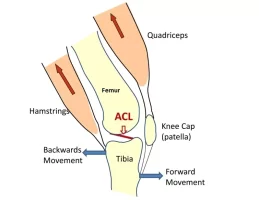
So when you have both activated, they provide a stabilized environment for the ACL and PCL ligaments. The knee is a hinge joint, meaning it only bends this way:
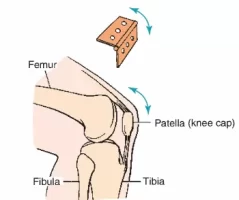
Those ligaments keep the joint from being able to shift. Basically, the MCL and LCL are on the sides of the knee… they keep the knee from collapsing parallel to the frontal plane (aka coronal plane) of the body.
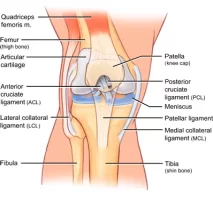
The ACL and PCL keep the tibia from shifting along the sagittal plane. You can find studies conducted about “squats” that claim all squats create a shearing force on the ACL and PCL ligaments, and that they should be avoided entirely.
There’s a lot wrong with those studies. First, they’re usually conducted with loaded squats well above parallel, which doesn’t activate the hamstring. Second, they use a back angle that is too upright, which further reduces hamstring involvement. There’s other things that they screw up, but suffice it to say, you can’t blame the exercise for knee pain if you don’t do it correctly.
Balance starts with the feet. If the feet are planted on the floor, and you aren’t coming up on your toes, your center of gravity is most likely balanced. If you can’t get into the bottom of the squat without your heels coming up, you likely have a mobility issue, or you’re not sitting back far enough in the squat.
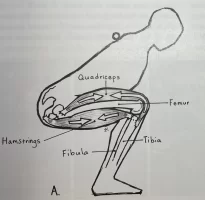
This is the bottom of the squat. The crease in the hip is below the knee. Yes, below! The further the center of gravity creeps off-center, the more the feet have to act to keep the body balanced. This isn’t ideal because a change in the feet impacts the kinetic chain all the way up. Going forward is especially bad because it reduces the involvement of the hamstring in the squat.
Range of motion… I’ve already said, the hip crease is below the plane of the knee cap. We’re not going to go any further, like an a$$-to-grass squat, because that requires that we relax the posterior muscles, which, again, removes the hamstring from the exercise. If you go just below parallel with a tight lower back, you ensure that your range of motion is limited by the hamstring stretch reflex. In other words, you’re going “bounce” off of the hamstring tension.
Lastly, we need to think about the angle of our backs during the squat. I keep saying the words low-bar back squat, and I’ll explain what that is now. When we sit around and think about squats like normal people do, we always have the same squat in mind… the bar rests on the traps, these nice muscles shown on the left:
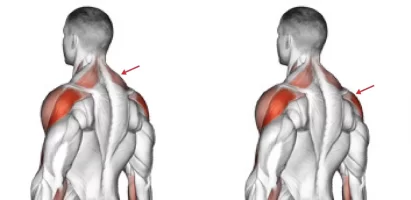
And they make a nice shelf. But if we tighten up the arms, flexing the rear deltoids (indicated in the right pic), we make a shelf that is closer to the hips.
What this does is it reduces the moment arm on the hips, which changes the back angle, which… increases, hamstring, involvement.
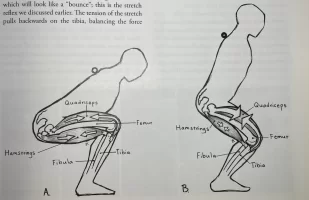
When the lifter above has a good back angle (left), close to 45 degrees, with his low back tight and neutral, his pelvis is rotated clockwise as we’re looking at it, which puts tension on the hamstring. But if he changes his back angle, like he does on the right, the pelvis is rotated counterclockwise respective to where it started, which releases tension on the hamstring, regardless of low back tension. If the muscle isn’t tight, it can’t pull on the tibia, and it can’t stabilize the joint. The back angle can be further maintained with a concept known as hip drive. Basically, you think about the hips leading the way out of the bottom of the squat. This keeps them from shifting backward.
This is why I recommend low bar back squats above any other, and I always recommend going past parallel. They’re just the safest way to do the exercise. It’s not to say that high-bar squats or front squats or goblet squats are dangerous for the knees, it’s just that low-bar squats have more activation of the posterior chain than other variations.
Now for squats and every other lift in the big 4/5, there are some other considerations. You have to keep the spine as neutral and rigid as possible. To do this, we’re going to have to ignore some more fitness advice. We’re not going to inhale on the way down and exhale on the way up. That’s not effective for maintaining spinal rigidity. We want to do a valsalva maneuver. Basically, at the top of the squat, we take a deep breath and HOLD it until we get back to the top. What this does is increases intrathecal pressure… that is, the pressure in the torso… basically, it creates a rigid column that’s connected to the spine. This keeps the spine from bending. You can increase the effectiveness of the maneuver by using a weight lifting belt. This allows your muscles something to brace against.
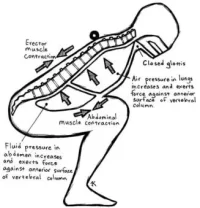
So that’s the crash course to the squat. While I’d like to go into more details about the other lifts I’ve mentioned, I feel like I’ve given you a roadmap to follow towards getting yourself strong for life, and that’s really the more important thing than just a bunch of exercise techniques.
This idea, of actively gaining strength, is a tough sell. I didn’t have a very good attitude towards it at first, since I grew up wanting to be like Arnold and Frank Zane. I didn’t realize that strength and muscles go far beyond vanity. And that by only doing a few key exercises, we can positively impact our ability for the long term and improve the way we do our desired physical activity is now.
Ultimately I can’t convince anyone to take on one of the linear progressions that I mentioned earlier if they just don’t want to. But I will ask you to ask yourself, why isn’t strength more of a priority for me? I told you the statistic earlier, we’re going to gain fat and lose muscle as we get older no matter what. So the more muscle and strength that we can accumulate now, the more we’ll have when we’re older.
After talking to several entrepreneurs, I’ve noticed that the more success with business that they have, the more they start to think about other things. One of those is time. You need to take your finite resource, time, and fill it with as many quality hours as you can. Personally, I haven’t found a better ROI than the results from the programs and training philosophy discussed above.
Get strong now, stay strong for life.
The Squat
Why the squat?
The squat is the most important, most impactful exercise I’ve talked about here, and that has ever existed. Second, some of the techniques involved in the squat also apply to other exercises, so it’s a good place to go ahead and learn them. Also, since the squat is seen by lots of doctors and physios as a knee destroyer, I want to explain why it’s actually quite safe to perform when performed correctly.
In the Starting Strength book, there is a pain-staking amount of detail about the squat. It’s a great read, but it can also be simplified a bit to three key principles:
- Balance
- Range of Motion
- Back Angle

So when you have both activated, they provide a stabilized environment for the ACL and PCL ligaments. The knee is a hinge joint, meaning it only bends this way:

Those ligaments keep the joint from being able to shift. Basically, the MCL and LCL are on the sides of the knee… they keep the knee from collapsing parallel to the frontal plane (aka coronal plane) of the body.

The ACL and PCL keep the tibia from shifting along the sagittal plane. You can find studies conducted about “squats” that claim all squats create a shearing force on the ACL and PCL ligaments, and that they should be avoided entirely.
There’s a lot wrong with those studies. First, they’re usually conducted with loaded squats well above parallel, which doesn’t activate the hamstring. Second, they use a back angle that is too upright, which further reduces hamstring involvement. There’s other things that they screw up, but suffice it to say, you can’t blame the exercise for knee pain if you don’t do it correctly.
Balance starts with the feet. If the feet are planted on the floor, and you aren’t coming up on your toes, your center of gravity is most likely balanced. If you can’t get into the bottom of the squat without your heels coming up, you likely have a mobility issue, or you’re not sitting back far enough in the squat.

This is the bottom of the squat. The crease in the hip is below the knee. Yes, below! The further the center of gravity creeps off-center, the more the feet have to act to keep the body balanced. This isn’t ideal because a change in the feet impacts the kinetic chain all the way up. Going forward is especially bad because it reduces the involvement of the hamstring in the squat.
Range of motion… I’ve already said, the hip crease is below the plane of the knee cap. We’re not going to go any further, like an a$$-to-grass squat, because that requires that we relax the posterior muscles, which, again, removes the hamstring from the exercise. If you go just below parallel with a tight lower back, you ensure that your range of motion is limited by the hamstring stretch reflex. In other words, you’re going “bounce” off of the hamstring tension.
Lastly, we need to think about the angle of our backs during the squat. I keep saying the words low-bar back squat, and I’ll explain what that is now. When we sit around and think about squats like normal people do, we always have the same squat in mind… the bar rests on the traps, these nice muscles shown on the left:

And they make a nice shelf. But if we tighten up the arms, flexing the rear deltoids (indicated in the right pic), we make a shelf that is closer to the hips.
What this does is it reduces the moment arm on the hips, which changes the back angle, which… increases, hamstring, involvement.

When the lifter above has a good back angle (left), close to 45 degrees, with his low back tight and neutral, his pelvis is rotated clockwise as we’re looking at it, which puts tension on the hamstring. But if he changes his back angle, like he does on the right, the pelvis is rotated counterclockwise respective to where it started, which releases tension on the hamstring, regardless of low back tension. If the muscle isn’t tight, it can’t pull on the tibia, and it can’t stabilize the joint. The back angle can be further maintained with a concept known as hip drive. Basically, you think about the hips leading the way out of the bottom of the squat. This keeps them from shifting backward.
This is why I recommend low bar back squats above any other, and I always recommend going past parallel. They’re just the safest way to do the exercise. It’s not to say that high-bar squats or front squats or goblet squats are dangerous for the knees, it’s just that low-bar squats have more activation of the posterior chain than other variations.
Now for squats and every other lift in the big 4/5, there are some other considerations. You have to keep the spine as neutral and rigid as possible. To do this, we’re going to have to ignore some more fitness advice. We’re not going to inhale on the way down and exhale on the way up. That’s not effective for maintaining spinal rigidity. We want to do a valsalva maneuver. Basically, at the top of the squat, we take a deep breath and HOLD it until we get back to the top. What this does is increases intrathecal pressure… that is, the pressure in the torso… basically, it creates a rigid column that’s connected to the spine. This keeps the spine from bending. You can increase the effectiveness of the maneuver by using a weight lifting belt. This allows your muscles something to brace against.

So that’s the crash course to the squat. While I’d like to go into more details about the other lifts I’ve mentioned, I feel like I’ve given you a roadmap to follow towards getting yourself strong for life, and that’s really the more important thing than just a bunch of exercise techniques.
This idea, of actively gaining strength, is a tough sell. I didn’t have a very good attitude towards it at first, since I grew up wanting to be like Arnold and Frank Zane. I didn’t realize that strength and muscles go far beyond vanity. And that by only doing a few key exercises, we can positively impact our ability for the long term and improve the way we do our desired physical activity is now.
Ultimately I can’t convince anyone to take on one of the linear progressions that I mentioned earlier if they just don’t want to. But I will ask you to ask yourself, why isn’t strength more of a priority for me? I told you the statistic earlier, we’re going to gain fat and lose muscle as we get older no matter what. So the more muscle and strength that we can accumulate now, the more we’ll have when we’re older.
After talking to several entrepreneurs, I’ve noticed that the more success with business that they have, the more they start to think about other things. One of those is time. You need to take your finite resource, time, and fill it with as many quality hours as you can. Personally, I haven’t found a better ROI than the results from the programs and training philosophy discussed above.
Get strong now, stay strong for life.
Dislike ads? Become a Fastlane member:
Subscribe today and surround yourself with winners and millionaire mentors, not those broke friends who only want to drink beer and play video games. :-)
Last edited:
Membership Required: Upgrade to Expose Nearly 1,000,000 Posts
Ready to Unleash the Millionaire Entrepreneur in You?
Become a member of the Fastlane Forum, the private community founded by best-selling author and multi-millionaire entrepreneur MJ DeMarco. Since 2007, MJ DeMarco has poured his heart and soul into the Fastlane Forum, helping entrepreneurs reclaim their time, win their financial freedom, and live their best life.
With more than 39,000 posts packed with insights, strategies, and advice, you’re not just a member—you’re stepping into MJ’s inner-circle, a place where you’ll never be left alone.
Become a member and gain immediate access to...
- Active Community: Ever join a community only to find it DEAD? Not at Fastlane! As you can see from our home page, life-changing content is posted dozens of times daily.
- Exclusive Insights: Direct access to MJ DeMarco’s daily contributions and wisdom.
- Powerful Networking Opportunities: Connect with a diverse group of successful entrepreneurs who can offer mentorship, collaboration, and opportunities.
- Proven Strategies: Learn from the best in the business, with actionable advice and strategies that can accelerate your success.
"You are the average of the five people you surround yourself with the most..."
Who are you surrounding yourself with? Surround yourself with millionaire success. Join Fastlane today!
Join Today

